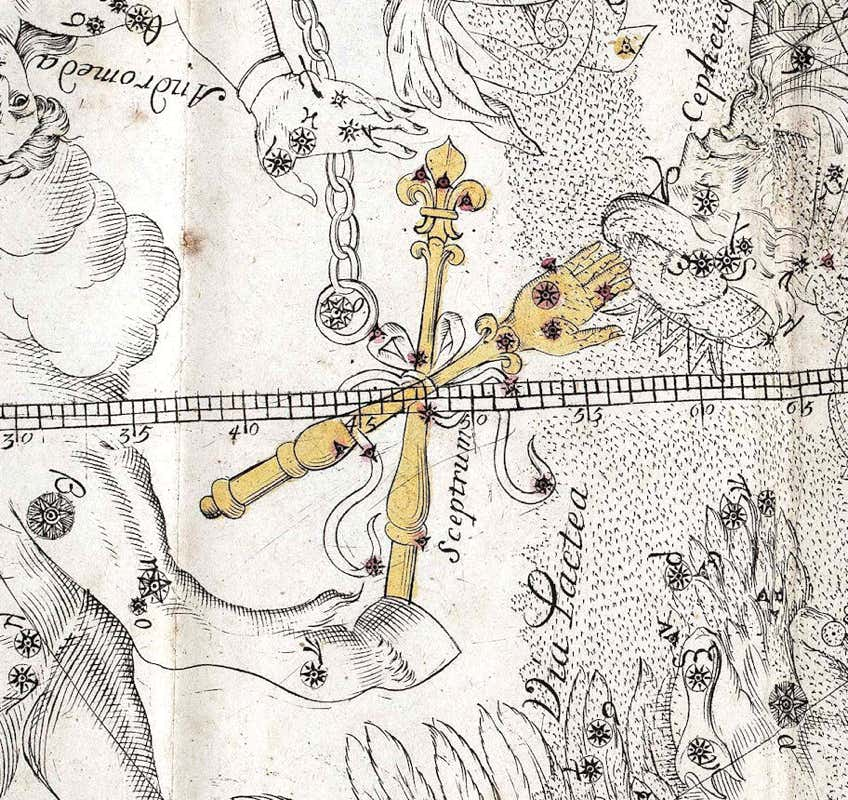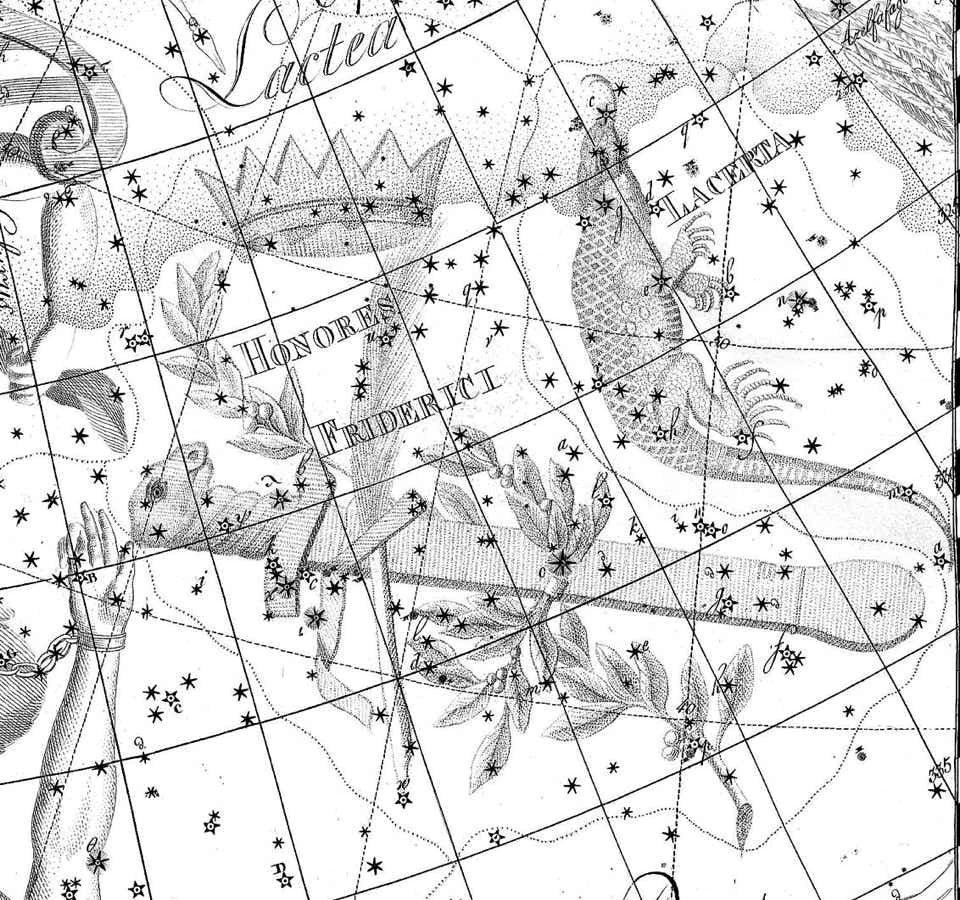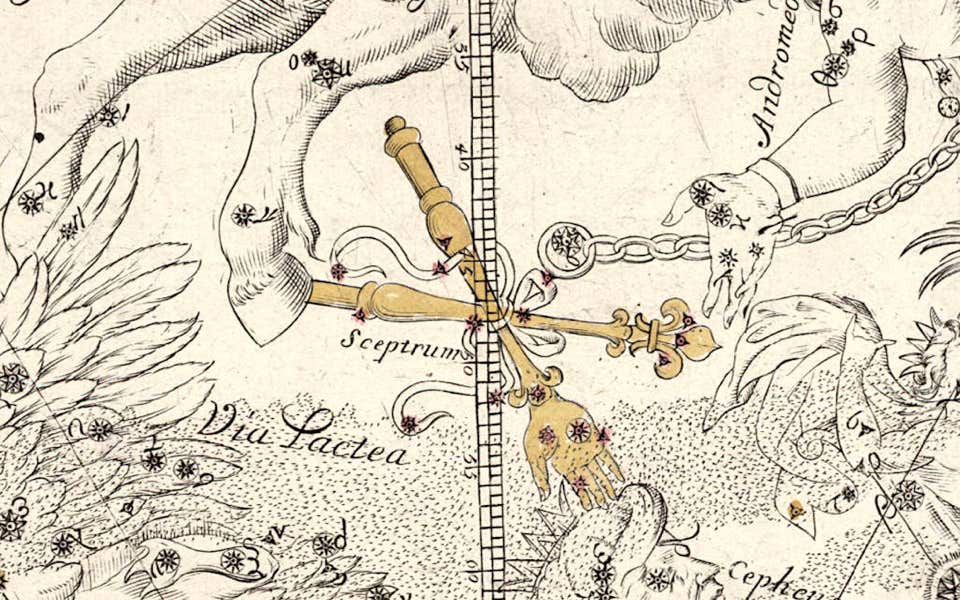
A constellation introduced by Johann Bode in 1787 to commemorate King Frederick the Great of Prussia, who had died the preceding year. An announcement of the new constellation was published in Bode’s own Astronomisches Jahrbuch (Astronomical Yearbook) of 1787 followed by a description and chart of it in the Mémoires de l’Académie Royale des Sciences et Belles Lettres of Berlin (1792).
Bode originally called it by the German name of Friedrichs Ehre, which can be translated as either ‘Glory’ or ‘Honour’, the former being the more archaic usage, but he Latinized the name to Honores Friderici on his Uranographia of 1801. Names for it found on other atlases include Gloria Frederici (Jamieson) and Gloria Frederica (Burritt), while R. H. Allen turned the name round to become Frederici Honores.
The constellation was squeezed between the outstretched right arm of Andromeda and the Hevelius invention of Lacerta, the lizard, both of which Bode adjusted to make room for it. Most of it lay in present-day Andromeda, but Bode also borrowed stars from Cassiopeia and Cepheus to the north as well as Pegasus to the south. Its brightest members were the present-day Omicron, Lambda, and Kappa Andromedae, all of 4th magnitude. In 2025 the IAU gave the name Honores to the star 7 Andromedae (labelled u on Bode’s chart); this star lies in the feather of the quill pen, and was chosen in recognition of the saying that the pen is mightier than the sword.
Honores Friderici, next to Lacerta the lizard, as shown on Chart IV in the Uranographia of Johann Bode (1801). It consists of a ceremonial sword entwined with a strand of laurel, a quill pen, an olive branch, and a surmounting crown to symbolize King Frederick of Prussia as a hero, philosopher, and peacemaker.
Sceptrum, the sceptre and hand of justice
A century earlier the French architect and astronomer Augustin Royer (life dates unknown) had placed in this same area his own patriotic invention, Sceptrum, representing the French royal sceptre and hand of justice, to honour King Louis XIV, the Sun King. It appeared on a chart in Royer’s Cartes du Ciel réduites en quatre tables published in 1679. He listed 17 component stars of 4th to 6th magnitude in an accompanying catalogue.
In the introductory notes to the catalogue he referred to it both as Sceptrum Regium & Justitiae Manus in Latin and Sceptre Royal & de la main de Justice in French, but in his catalogue and chart he named it simply Sceptrum. Royer noted that the constellation ‘passes through the zenith of the residence of our great monarch and the capital of his States’ [i.e. Paris]. However, the overtly nationalistic Sceptrum never became established and was soon displaced by Hevelius’s Lacerta.
Incidentally, the Latin name Sceptrum et Manus Iustitiae found in the popular literature for this constellation seems to have first appeared in Julius Staal’s 1988 book New Patterns in the Sky, but this form of words was never used by Royer himself, or indeed by anyone else before Staal.
Sceptrum, representing the French royal sceptre and hand of justice, on a chart published in 1679 by Augustin Royer.
© Ian Ridpath. All rights reserved

Sceptrum, representing the French sceptre and hand of justice, on a chart in Cartes du Ciel published in 1679 by the French architect and astronomer Augustin Royer (life dates unknown). He listed 17 component stars of 4th to 6th magnitude in an accompanying catalogue.




